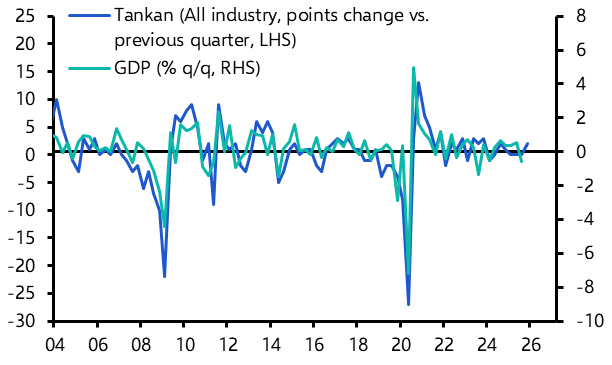Brexit, oil and tech stocks grabbed the headlines last week but it was third quarter GDP data from Germany and Japan that provided the most ominous signs about the outlook for the global economy.
Japan’s economy contracted by 0.3% q/q in the third quarter, while Germany’s contracted by 0.2% q/q. The sheer size of both economies – which are respectively the third and fourth largest in the world – mean that they play an important role in driving global growth. But the fact that they are also relatively open raises the prospect that their recent struggles might also tell us something about the health of the global economy more generally.
Given how export-orientated both economies are, it is perhaps inevitable that their poor performance in Q3 is being blamed on “trade wars”. Yet this interpretation is unconvincing. For a start, despite the breathless commentary, the various tariffs that have been imposed so far have covered only 2% of world trade. What’s more, they have been focussed mainly on China and, due in part to front running of the tariffs, its exports have actually strengthened in recent months.
Instead, it is more likely that the weaker data from Japan and Germany can be explained by a series of one-offs. In Japan, economic activity in the third quarter was disrupted by a number of natural disasters, including floods in the south of the country in July. Meanwhile, Germany’s manufacturing sector was hit by particularly hard by new car emissions tests, which pulled down vehicle production. In both cases the disruption should be temporary and we expect activity to rebound in Q4. And in the meantime it’s worth noting that growth in the US, UK and several other economies, including many in Central & Eastern Europe, is chugging along at a decent pace.
So does that mean there’s nothing to worry about? Not quite. For a start, even after accounting for the one-offs that affected Q3 growth there are a signs of an underlying slowdown Germany’s economy and, indeed, that of the wider euro-zone. Even without the disruption to the auto industry we estimate that Germany economy would have grown by only 0.1% q/q in Q3 (down from 0.5% q/q in Q2).
More fundamentally, a deeper look at the data reveals that several early warning signs of a global slowdown are starting to flash, if not red, then amber. The table below shows six indicators we follow that tend to move closely with the economic cycle. Five of them fell in Q3, and the one that did increase (world trade volumes) only did so after a weak Q2. None are consistent with an imminent collapse in world growth and, given the usual volatility in the data, I wouldn’t rule out an upturn in some of these indicators over the coming weeks and months. But as things stand, it’s difficult to escape the conclusion that the global economy is losing some steam.
| Indicator | Q2 | Q3 (or latest) | Movement |
| Global Manufacturing PMI | 53.2 | 52.1 | |
| Global Composite PMI | 54 | 53.0 | |
| MSCI World Equity Index | 588 | 571 | |
| GSCI Industrial Metals Index | 386 | 331 | |
| World Trade Volumes | 0.0% q/q | 1.7% q/q | |
| East Asia Trade Volumes | 0.5% q/q | -0.9% q/q | |
Stepping back, then, two points are worth stressing. First, the weakness of third quarter GDP data from both Japan and Germany may not be as alarming as it appears at first sight and almost certainly doesn’t reflect escalating “trade wars”. But dig a bit deeper and there are signs that the global slowdown we’re forecasting for 2019 is starting to appear on the horizon.
In case you missed it:
(Requires login)
- Our US team argues that core inflation in America has already peaked.
- Our Chief Commodities Economist, Caroline Bain, explains why this week’s sharp fall in oil prices sets the stage for further weakness in 2019.
- We take stock of the economic consequences of this week’s Brexit tumult.



